Peter MALONE
Mr Blandings Builds His Dream House

MR BLANDINGS BUILDS HIS DREAM HOUSE
US, 1948, 94 minutes, Black and white.
Cary Grant, Myrna Loy, Melvyn Douglas, Reginald Denny, Louise Beavers.
Directed by H. C. Potter.
Mr Blandings Builds His Dream House is something of a post-World War Two comedy classic. It is reminiscent in its sharp dialogue and sophistication of the screwball comedies of the 1930s – which featured the three main stars. However, it is very strongly influenced by the post-war experience, especially of families building houses and making a new life in this period.
Cary Grant and Myrna Loy are a couple who decide that they want to move to the country and build a house according to their own specifications. This is a Murphy’s Law kind of situation where everything goes wrong. This provides a great deal of the comedy as does the interrelationship between Grant and Myrna Loy, both expert at this kind of film. Melvyn Douglas as the friend is also expert.
The film is very much a look at the American situation of the period – and, with Myrna Loy, harks back to the 1946 best film Oscar-winner, The Best Years of Our Lives.
The film was directed by H. C. Potter who made a number of films in the 1930s and 40s with such variety as The Farmer’s Daughter, The Miniver Story. The screenplay was written by Norman Panama, who wrote a number of comedies with Melvyn Frank including the Danny Kaye classics Knock on Wood and The Court Jester. The film was remade in the 1980s as The Money Pit with Tom Hanks and Shelley Long. It was also adapted in 2007 for the Ice Cube comedy, Are We Done Yet.
1. Was this a good comedy? Was it a good example of the ordinary man comedy genre?
2. As a picture of America after the war? was it humorous and telling? Is the film now dated? In content? In Style?
3. How humorous and visually portrayed were the comments on the rat race, life in the country, the worries of the Americans?
4. How were the Blandings' worries typical of the concerns of modern people? Ambitions, greed? poverty? extravagance? How was the house, the planning and all the preparations symbolic of this? Were they effectively portrayed?
5. Was Jim Blandings an attractive character? Was the audience sympathetic towards him? The fact that Cary Grant played him? His job? His involvement with Wham? His relationship with his wife and children (getting up, the shaving, the meals etc.) Did he think into things? How much of a fool was he?
6. Muriel Blandings? was she meant to typify the average American woman? If so, what is your opinion of the average American woman? her weaknesses? her strengths? The fact that Myrna Loy played this part?
7. What was the point of Bill Cole in the film? His narrative? His common, sense and criticism of the scheme? For comedy? For some kind of romantic rivalry? Was this effective? Did he make enough contrasts with Jim Blandings?
8. Many of the situations were light and frothy. How humorous were they? at home in New York, in the buying of the land, the pulling down of the house,, the details of the building of the house?
9. What was the final message about ambition and pride and
greed?
10. How optimistic was the ending of the film? Over optimistic or sensible?
Murder She Said/ 1961
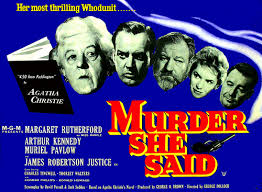
MURDER SHE SAID
UK, 1961, 87 minutes, Black and white.
Margaret Rutherford, Arthur Kennedy, James Robertson Justice, Charles Tingwell, Muriel Pavlow, Thorley Walters, Stringer Davis, Joan Hickson.
Directed by George Pollock.
Murder She Said was the first in a series of four films from Agatha Christie novels, featuring Margaret Rutherford as Miss Jane Marple. The series was filmed in black and white, had short running times, were directed by George Pollock. Australian Charles Tingwell became a regular as Inspector Craddock. Margaret Rutherford, in her early seventies, brought her comic zest to the role. She also had an opportunity to act with her husband Stringer Davis.
Murder She Says was based on the novel Four Fifty from Paddington. The technique of the series was to focus on a murder situation, get Miss Marple involved have the police disbelieve her, round up a series of suspects
especially the family, divert attention from a central character who was unobtrusively present and then unmask this character as the villain. Arthur Kennedy as the family doctor was thus unmasked in this film. The films had a jaunty score by Ron Grainer.
1. The appeal of Agatha Christie's novels? Her techniques especially in drawing readers' attention away from the Villain? The appeal of the detective story, the detective, the mystery, Agatha Christie's world, her delineation of characters? The anticipation of these qualities in film versions of her work?
2. The appeal of Miss Marple as a detective? An old lady being able to solve mysteries that the police cannot? How suitable is Margaret Rutherford for portraying Miss Marple? Margaret Rutherford's character styles, impact?
3. The small budget of the films and their brevity? black and white photography, Ron Grainer's special jaunty score? The use of British stars? The settings and Hiss Marple** Tory old-fashioned and British world?
4. The technique of setting the mystery and the crime and alerting the audience? The introducing of Miss Marple, sketching her character, showing the reasonableness of her involvement? The disbelief of the police and their growing trust in Miss Marple?
5. The setting of the characters and briefly sketching in their characteristics? Scenes contrived to make the audience suspicious? The clashes of the characters amongst themselves?
6. A nice blend of comedy sequences with suspense sequences? The atmosphere of Miss Marple searching for clues, gaining allies, lulling the villain into a false sense of security?
7. The preparation for the denouement, Miss Marple's participation, her lulling the villain into confessing? The real danger and threat to Miss Marple's life? How satisfying the bringing of the investigation to a conclusion?
8. The films and their portrayal of right and wrong, evil and motivation, the details of investigation, poetic justice?
Murder at the Gallop was the second in the series of Miss Marple thrillers adapted from Agatha Christie novels and directed by George Pollock. This film was based on After the Funeral. Robert Morley features very strongly in this film and brings his comic talent and style. Flora Robson takes over the Arthur Kennedy role from the first film and finally she is unmasked as the villainess. This film gave Margaret Rutherford an opportunity for Miss Marple to say things about Agatha Christie and also for the unusual sight of Margaret Rutherford and Stringer Davis doing the Twist. It was a good successor to the original.
Major and the Minor, The
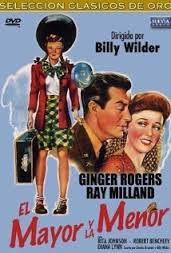
THE MAJOR AND THE MINOR
US, 1942, 100 minutes, Black and white.
Ray Milland, Ginger Rogers, Rita Johnson, Robert Benchley, Diana Lynn.
Directed by Billy Wilder.
The Major and the Minor was an enjoyable war comedy, featuring Ray Milland and Ginger Rogers. The play on the name indicates that part of the comedy came from a mix up of ages, but in a military setting. It was one of the earliest films written and directed by veteran Billy Wilder, who man to go an and make such films as The Lost Weekend and The Apartment for which he won Oscars.
The comic ingredients wore successful during the war. They were also popular after the war and Paramount who own the story adapted it as a vehicle for Dean Martin and Jerry Lewis. This was You’re Never Too Young. The military situation went. The play on ages remained. This time Jerry Lewis took the Ginger Rogers role and the Ray Milland role was divided between Dean Martin and Diana Lynn. You’re Never Too Young is clearly for Martin and Lewis humour and does not have the subtlety of the original. However it is quite enjoyable in itself. And it shows what can be done in adapting an original story, The same thing was down for Martin and Lewis in the adaptation of Nothing Sacred into Living It Up.
1. The tone of the title, its wit? Themes?
2. The atmosphere of 1941, the times, New York, war, fashions, etc.?
3. The film was Billy Wilder's first film as director. His later qualities and reputation? The style of humour, irony, farce? Critical comment and satire on the times and characters?
4. How credible was the structure of the film? Character, behaviour? Was this important or not?
5. How did the themes of men and women, love, power, war etc. come out via the humour?
6. The comedy of the opening, indications of sex comedy especially with Mr Osbourne and the lift driver, Susanne and her reaction? To Mr Osbourne and the lift driver? The girl who came from the country dissatisfied with the city and wanting to return home? The critique of the artificiality and predatory nature of the
7. The humour of her not being able to pay her way, the decision to be a little girl, the openings for farce? How well and humorously were these handled? The picture of Ginger Rogers posing as a twelve year old? The ambiguities of her behaviour? Her needing to be innocent while knowing? Why does this kind of disguise appeal to audiences?
8. What kind of person was Susan, the qualities of her character? The motivation for her decision, her hiring a daddy who swindled her of the money, her behaviour on the train, trying to outwit the guards, with her smoking etc? Her throwing herself at the Major and her not realising that she was a minor?
9. The portrayal of the academy? The background of war, yet the satire on the cadets and their wolfish behaviour, their strategy of the line? The satire?
10. The portrayal of Pamela: her initial jealousy, motherliness, hostility to Susan? The revelation of how selfish she was in manipulating Philip's life? Her deserving to lose Philip and being exposed? The satire on the greedy and powerful American woman?
11. The contrast with Lucy, the real child who saw the truth? The reason for her helping Susan?
12. How credible a character was Ray Milland and his style, his desire to be in action, his benevolent teasing of the cadets with Susan's presence? His inability to see through Pamela? His falling in love with Susan? His visiting her at the end? Did he deserve the happy ending? The American male?
13. The quality of the farce for e.g. Susan's attacking the switchboard, the dance, Mr Osborne pursuing her identity?
14. How well handled was the revelation of the truth? Pamela's blackmail? Mr Osborne's story? (satire with Mrs Osborne?)
15. The change of tone as Susan was at home with her mother, breaking off with her potential fiancee? How well did Susan portray her own mother when Philip visited?
16. How satisfying was the happy ending? How valuable is this type of comedy in its time, now?
Malaya
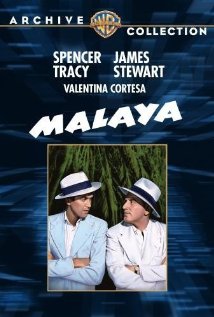
MALAYA
US, 1949, 98 minutes, Black and white.
Spencer Tracy, James Stewart, Valentina Cortesa, Sydney Greenstreet, John Hodiak, Lionel Barrymore, Gilbert Roland.
Directed by Richard Thorpe.
Malaya is based on actual events. Lionel Barrymore plays a real-life editor who thought up the plan for getting rubber from Malaya, away from the Japanese, to help the war effort.
The film is a buddy movie, surprising when the two buddies are played by James Stewart and Spencer Tracy. Stewart portrays a young idealistic type while Spencer Tracy is the cynical man who has been released from prison. The supporting cast includes Sydney Greenstreet, doing his usual thing, in his last film. Valentina Cortesa made a number of American films at this time before returning to Italy.
The film is action adventure, a glimpse back at the war situation, an interesting look at the tough kind of hero, Warner Bros style, played by Spencer Tracy.
James Stewart’s first film, in fact, was Murder Man in 1935 which starred Tracy.
The film is directed by Richard Thorpe who directed many films at MGM and went on to make some of their action historical spectaculars like Knights of the Round Table and Quentin Durward. He directed Robert Taylor in quite a number of films.
1. An entertaining action adventure?
2. Black and white photography? M.G.M. production values? Atmosphere of Eastern locations? The contrast between American and the East the war atmosphere? Musical score - addition of songs, for example 'Blue Moon' sung by Luana?
3. The conventions of the war film and the adventure drama in the East? The adventures, the war, the sleazy atmosphere, heroic, action and betrayal, heroics and final triumph? How well done? combination of the talents of Spencer Tracy and James Stewart and their particular styles?
4. The film was based on factual incidents. How authentic did the personalities and the plot seem? Contribution to the war effort and America's involvement? The background of John Royer, his journalistic work? John Manchester and his ideas about rubber and its place in the war effort? The American officials and their attitude towards the question? Royer and his contacts especially Carnaghan? The heroics, the contacts, the personalities and the adventurers in Malaya itself? The strategies for getting the rubber? Dangers and risks? A tribute to the personnel involved? Good material for action drama?
5. The film's initial focus on Royer? His abrasive personality, the background of his work? Being approached by the government and his ideas? His contacts with American officials? The joining up with Carnaghan and their hostility from the past? Royer persuading Carnaghan to be involved? Their work together, their attitudes to work, the pressure that they put on the rubber plantation owners? The personal involvement and emotions especially with Luana? The collaboration with the Dutchman? Royer's heroics and the saving of Carnaghan? The achievement of Royer?
6. Spencer Tracy's style as Carnaghan? prison background and his resentment towards Royer? His motivation for becoming involved? His links with the Dutchman and his power of persuasion? Being reunited with Luana and the bond between them? His heroics in contacting the plantation owners and persuading them to give their rubber? The brushes with the Germans? The skill in his strategy and manoeuvres? The war and the risks that were presented? His achievement?
7. The presentation of the Americans especially Manchester and Kellar? The memoirs of Kellar?
8. The people in Malaya especially the Dutchman at his saloon, the people who not there? Luana and her presence, the exotic touch of the siren? Romano and the other adventurers who were employed?
9. The presentation of the plantation workers and the risks with their rubber, the motivation for letting the rubber go, the hopes of payment? The varied personalities and the dangers? Their response to Carnaghan?
10. The adventure sequences and especially the dangers and the possibility of Carnaghan's death and the way that he carried off his escape? Timing, the American Navy to the rescue?
11. How satisfying an entertainment? Audience response to the adventure ingredients and identification with the adventurers? The background of patriotism?
Maltese Falcon, The/ 1941
THE MALTESE FALCON
US, 1941, 101 minutes, Black and white.
Humphrey Bogart, Mary Astor, Gladys George, Peter Lorre, Barton Mac Lane, Lee Patrick, Sydney Greenstreet, Ward Bond, Jerome Cowan, Elisha Cook Jr.
Directed by John Huston.
The Maltese Falcon is an American classic. It was entered on the National Registry in 1989. It was nominated for Oscars for writing, Sydney Greenstreet’s performance, best picture.
The film is based on the novel by Dashiell Hammett and features his private eye, Sam Spade. There had been a version of The Maltese Falcon in 1931, directed by Roy Del Ruth, starring Ricardo Cortez. However, Humphrey Bogart made Sam Spade his own.
The plot is particularly complicated – and, in the final five minutes, Sam Spade makes an attempt to put forth all the aspects of the plot, all framed in conditions and what if …? It requires attentive listening, indicative perhaps of the capacities for 1940s audiences to listen to dialogue.
Mary Astor is the femme fatale – and won an Oscar in this year for her performance in The Great Lie. The usual suspects are there, especially Peter Lorre, Sydney Greenstreet, Elisha Cook Jr – with the ambiguous relationship of Elisha Cook Jr to Greenstreet and the evocative sexual undertones and symbols.
The film set something of a tone for the film noir of the 1940s.
This was the first film directed by John Huston. He had been screenwriting in Hollywood since the 1930s. However, this was the beginning of a forty-five year career as a director. He made quite a number of classics: Key Largo, The Treasure of the Sierra Madre (where he directed his father Walter Huston to an Oscar), The Red Badge of Courage, The African Queen, The Misfits. He also directed his daughter, Anjelica Huston, to an Oscar in Prizzi’s Honour. His last film was a version of James Joyce’s The Dead in 1987.
1. Why is this considered a classic thriller? What are its most important features? Its entertaining features?
2. What conventions off the private-eye thriller does it use best? How well? Why?
3. What insight into the style of the forties films does this film give? Into the style of the thirties as regards America detection, tough style etc.? What convention is there in the private eye and his detection, the tough American hero, the Humphrey Bogart style etc., the swift and smart dialogue and wisecracking, the shoot outs and the assertion of force?
4. How typical a Humphrey Bogart role is this? What kind of character does he endow Sam Spade with? What values does Sam Spade stand for? investigation, his attitude toward his partner and investigating his death, his attitude toward women, Effie? Miss Shaughnessy, Iva Archer? attitudes towards right and wrong? Towards the police? His belief in himself and his abilities? His attitudes his fellow men?
5. Comment on Mary Astor's portrayal of the villainess. In the forties style? her English mannerisms concealing her cunning evil? Her use of love and her manipulating people? A calculated innocence as the American villainess? How impressive was this portrayal and the insight into wickedness?
6. The portrait gallery of villains in this film: Goodman as played by Sidney Greenstreet, suave style of the fat man, his snobbery, his ambitions for wealth, hie efficiency and inefficiency, his cruelty and callous disregard of Wilmer, his ironic and British comments etc.?
7. Cairo as portrayed by Peter Lorre, small and suave, insinuating, slimy, evil and cruel?
8. Wilmer and the young punk, inarticulate and brutal, sacrificed by the others? Critics have seen this rogue's gallery as effective cinema. Do you agree?
9. How do the police compare in portrayal with the villains? Do they have the similar character drives? The function of the police in the film? The director's attitude towards the police?
10. How interesting is the crime and its details? Difficult to follow? The implications of the robbery, attitudes towards life and death, greed and using of others?
11. How strong is the film in its portraying of the interaction of its characters? Their basic humanity and inhumanity? Insight into personalities? American society and presuppositions and styles?
12. What would have been the major interest of the film in the forties? What is its major interest now?
Man and a Woman, A
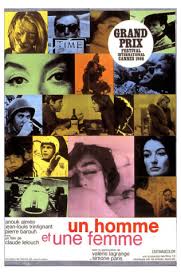
A MAN AND A WOMAN
France, 1966, 102 minutes, Colour.
Anouk Aimee, Jean- Louis Trintignant.
Directed by Claude Lelouch.
A Man and a Woman is one of the best-known and popular of French films. It won the Oscar for best foreign language film of 1966 and Lelouch and his screenwriter, Pierre Uytterhoeven, won the Oscar for best original screenplay. (Uytterhoeven has been writing films since 1964 and has continued over four decades – frequently collaborating with Lelouch.) Lelouch and Uytterhoeven made something of a commercial mistake in creating a sequel, A Man and a Woman Twenty Years Later in 1986. It was not so popular, critics and the public thinking that it undermined the original film.
The plot is very simple. A widow and a widower meet accidentally at their children’s school. They drive together, explain their lives to each other. (The film also has a racing car background, a theme very popular in the 1960s with such films as Grand Prix.)
Jean- Louis Trintignant and Anouk Aimee are very attractive as the couple and helped audiences identify with characters and themes. The film uses both Technicolor and black and white for dramatic effect.
The film’s score also became very popular, especially with the song ‘A Man and a Woman’ composed by Frances Lai who was to go on to create the score and the song for Love Story.
The film won the Golden Palm at Cannes in 1966 as well as the OCIC award.
1. The overall impact of the film, the quality of audience response? The popularity of the film and the reasons for it? Its meriting the Oscar that it won? A film that signified trends and has created trends?
2. The puzzle of the use of colour? the use of monochrome? Any reasons? The effect? Changing of moods?
3. The importance of the music? The heavy dramatic theme, especially for the car on the road? The use of songs, especially for Anne's husband? The song and the memory, song at the and? The visuals that accentuated these two songs? The importance of the main them and its effect? A romantic theme for a romantic film?
4. The place of the title? The focus on the relationship between a man and a woman? The indication of the theme? How well did each character represent men and women? How particularly French? How universal? The ordinary man and woman of the twentieth Century? The film's comments on its own story, the mention of movies and real stories, the opening fairytale and people not liking a sad story? How happy and moving a story was this? How genuine in its happiness and romance?
5. The portrayal of love and audience response to this? Audience response to a love story? How strong was the story? How strong was the power of love? The atmosphere of romance and sentiment? How well presented, how well balanced?
6. The importance of the structure of the film and audience response to this: the introduction of each character, meeting with them and their children, the story as it unfolded - at that point, the dramatic structure for the flashbacks, the growth in meeting and understanding, the importance of the cable and the long drive, the new meeting in love, the culmination of the physical love, Anne's hesitation, the second drive and the finale? How did this keep audience attention and keep the audiences involved with the characters?
7. How attractive a character was Anne, in herself, in relationship to her daughter? The background of the school, her telling stories, the capacity for love? The ordinary meeting with Jean Louis? The strategic presentation of the flashbacks and the gradual build-up of detail? The nature of her love for her husband? How convincing with this, the exotic background of the stunt work? for growth of response to Jean Louis? Travelling with him and the importance of the lunch and the conversation and the naturalness, the walk along the beach, the boat ride? The realization of love? The reason for her sending the cable? The happiness at the reunion, the dramatic significance of her husband not being dead for her? What did she realize during the final train ride? How probing and convincing a character study of a woman?
8. How attractive a character was Jean Louis? Our meeting him with his boy, seeing him at work, the sadness and pathos of his story, his response to Anne's story? His mistress and kissing her? The gradual realization of love? His work at Monte Carlo and Anne's absence? The dramatic impact of the cable and the strength and power of love in his drive? His pursuing Anne to the school? The fulfilment of the love? His disappointment and seeing her off at the train? What happened to him during his final drive? How interesting and accurate a portrait of an ordinary man in love?
9. The strength in the film of such sequences an the lunch, the easy talk, the picture of natural relationships, the enjoyment of the beach and the boat, the discussion about the dog and sculpture and the contrast of the later dog running around the beach in exhilaration?
10. How much insight did the film have into the strength and power of love and its moving people?
11. The importance of the encounter in the bedroom, the memory, Anne's memory and the son, her having to accept her husband's death?
12. The dramatic impact of the final trip and audience response to this? How involved were audiences by this time?
13. Twentieth Century background of filmmaking and car racing and the visualizing of this? How important? The film's reliance on details and charm, beauty? The quality of its insight and feeling?
Man at the Top
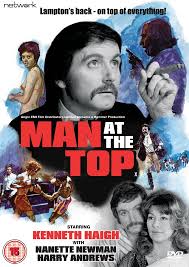
MAN AT THE TOP
UK, 1973, 92 minutes, Colour.
Kenneth Haigh, Nanette Newman, Harry Andrews, William Lucas, Clive Swift.
Directed by Mike Vardy.
Man at the top is a sequel to the celebrated 1959 film, based on the novel by John Brain, Room at the Top with Laurence Harvey and Simone Signoret. Laurence Harvey took up the role of Joe Lampton again in Life at the Top in 1964. There was also a television series based on the novel.
After many years, Joe Lampton is at the top, mixing it with high society and big business – and the moral problems of the 1970s.
1. The title, reference to Joe Lampton, the previous books, films, television series? This film within this series and its quality? Impact?
2. Audience consciousness of Joe Lampton over two decades as an Englishman, working class, worked his way to the top, restlessness? His impact in the 50s, in the 60's, his change in the 70's as he works at the top? A reflection of what had happened to so many young Englishman in the decades after the war? how attractive a symbol of this character?
3. The background of the television series, the plot stretched to feature length, the structure of incidents, the character delineation? Enjoyable as a film?
4. The background of the executive suite world, the picturing of corruption? Audience interest in this kind of world and its evil? Remote from the audience and therefore fascinating, or not? Joe repellent? How authentic did this world seem?
5. Joe Lampton as the loner, separated from wife, a man who hurt people, a man who teased at business problems, his resentfulness at being ousted, his encounter with the hitch hikers and what this revealed, his conduct at meetings, blackmailing people, seduction of his boss's wife and daughter, participation in the hunt, his hold over Lord Akerman, his promotion? A career of corruption and evil? Any redeeming features?
6. The cynical nature of the film and the presentation of Joe Lampton? Joe as a cynical person with no values except at being at the top?
7. Lord Akerman and what he stood for, the presentation of the ugly British business, evil and unscrupulous, covering up? Wife and daughter? Handling work meetings at the hunt? Defeated by Lampton? A strong characterisation, how well illustrated?
8. The roles of Alex and Robyn in the film? Towards Lord Akerman, the business world, seduced by Joe?
9. The African background, the drugs and sterility, the social evil and injustice, the cover-up? The suicide of the executive? A symbol of today's corrupt business world?
10. The cynical ending with jobs for the boys and everything continuing as such?
Madigan's Millions / Un Dollaro Per 7 Vigliacchi

UN DOLLARO PER 7 VIGLIACCHI (MADIGAN'S MILLIONS)
Italy, 1967, 86 minutes, Colour.
Elsa Martinelli, Cesar Romero, Dustin Hoffman.
Directed by Giorgio Gentili.
Madigan’s Millions is an Italian production with a Spanish screenwriter. It is interesting principally for one of the earliest roles of Dustin Hoffman, playing a Treasury Department agent who is tracking down a million dollars owed to the government by a deported gangster, played by Cesar Romero.
The film is slight – and was released only after The Graduate when Hoffman had made a significant impact.
1. Was this an entertaining comedy? Why?
2. The film received only minimal theatre release. Why? Was the film of poor quality? Was it a financial risk?
3. How did the film satirise the United States and Italy? Did it do it well?
4. How broad was the satire of the film? Of personalities as well as national ways of behaviour? Was the satire effective or would audiences have just considered the comedy?
5 The character of Jason Fister? was he a rounded character, a caricature? How did Dustin Hoffman make him a comic character? Especially the 'little man'? Was his behaviour too far-fetched and stupid? Or genuinely comical and satirical of Americans and of women?
6. What was being satirised in Arpo as an Italian policeman looking like a gangster? Burke as the American diplomat?
7. The picture of gangsters in Rome? how comic was this? How realistic? Did it genuinely add suspense to the comedy?
8. Did the character of Vicky and her son add anything to the film? What? What kind of a person was Vicky?
9. Did the film have genuinely human elements as well as its comedy?
Madeleine
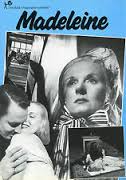
MADELEINE
UK, 1950, 101 minutes, Black-and-white
Ann Todd, Norman Worland, Ivan Desney, Leslie Banks, Elizabeth Sellers, Edward Chapman.
Directed by David Lean.
Madeleine is based on a true story, of a marriage, of a murder, of a trial. The film has a Scottish setting.
The film was a star vehicle for Ann Todd, an English actress who had also appeared in Hitchcock’s The Paradine Case. At this stage of her life, she was married to director, David Lean, who also directed her in Breaking the Sound Barrier.
The film has a supporting cast of veteran English actors.
After Breaking the Sound Barrier, Lean was to direct Summertime with Katharine Hepburn. For the next 30 years he was to make only a few films, all of them celebrated, Oscar winners and nominees, spectacular action and pageant films: The Bridge on the River Kwai, Lawrence of Arabia, Doctor Zhivago, Ryan’s Daughter, A Passage to India.
The Bridge on the River Kwai and Lawrence of Arabia both won Best Picture Oscars as well as Best Director for Lean.
1. How interesting was this drama? It spoke of two human beings and their story? Was this the main interest? How strong was the insight into murder and the nineteenth century background?
2. Was the flashback technique successful? The focus on a twentieth century house with 20th century curiosity?
3. Your initial impression of Madeleine? How wilful and self-centered? How much part of her class in Glasgow? Her intimidation by her father? Her fear in her love, lies? The fact that she was suffering the consequences of her deceit? Was she an attractive character? presented as a heroine?
4. Was Smile an attractive character? What kind of man was he? In his social position? Did he really love Madeleine? Was he after her wealth and position? Was his brutal treatment of her justified? Was he too manic? His threats?
5. Did the film show what actually happened? Or did it merely illustrate that the case against Madeleine was not proven? Did directors and screenwriters have an attitude towards Madeleine's guilt or innocence? Which sequences could indicate this? The significance of her smile at the and? Were audiences meant to be sympathetic with her and believe in her or not? Why?
6. How important were the details of family life? The formal style of the 19th century? Which details illustrated this best? the personality of Mr Smith and his hold on his family?
7. How attractive was Madeleine’s fiance? As a contrast with Emile? Why did she consent to engagement? Did Madeleine love him ever? his reaction to her, her confronting the trial? His reaction in leaving the court?
8. The importance of the maid in the film? her having her lover in the in the house quietly as Madeleine did? the class comments as regards men/women relationships?
9. What did the film show of circumstantial evidence? Its overwhelming importance against Madeleine? The way that it could be interpreted in her favour? Can justice be done via circumstantial evidence?
10. How successful were the trial sequences? Getting audience attention and response? The visual presentation of the court? Lawyers, the public, Madeleine's performance at the trial?
11. How skilful was the prosecution? How emotional his arguments? Was it an adequate prosecution of Madeleine?
12. How strong was the defence speech? His skill in the analysis of the circumstantial evidence? After hearing his speech, could the jury have voted guilty? Was not proven as adequate just verdict? What would be the effect for Madeleine's future life?
13. What judgements of behaviour in the 19th century were implicit in the film, the surface morality and manners, the ambitions of the upper class, clandestine meetings, the way that people responded to such models, the public and the jostling of the coach seat, the newspaper headlines? How different from century to century?
14. Did the film give insight into human behaviour and motivation? Did the film invite judgements on behaviour from the audience?
Madigan
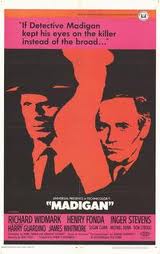
MADIGAN
US, 1968, 100 minutes, Colour.
Richard Widmark, Henry Fonda, Inger Stevens, Harry Guardino, James Whitmore, Susan Clark, Michael Dunn, Steve Inhatt, Sheree North, Don Stroud, Raymond St Jacques.
Directed by Don Siegel.
Don Siegel had established a strong reputation at the end of the 1950s fought tough films, especially police films. By the end of the 1960s, his reputation had advanced with such films as To Mules for Sister Sarah and The Beguiled.
This is a precinct film three years before his classic Dirty Harry. Richard Widmark Henry Fonda are very good as to police on the search for a criminal. This film relies on Siegel’s toughness, strong characters, interaction, touches of violence.
1. Was this a good police thriller? Comment on its sharp terse style. The nature of the opening with the presentation of New York? The structure of the three days and the quest for Madigan and his associate to get the murderer?
2. Impressions of the Madigan type hero? What aspects of heroism did Madigan have? What were his limitations? What attitude did the film take towards Madigan? How well did he fit into the New York world? How important was this relationship between the policeman and his world? For frustration?
3. What did the film have to say about good and evil? Right and wrong? The book? The letter of the law and human rights? Which characters and sequences best illustrated this?
4. What insight into the criminal mind and behaviour did the film give? The nature of criminal evil? The work of the police? The demands made on them and their responsibilities?
5. What attitude did the film take towards police methods: being tough, violent, blackmailing and persuading people? What was your attitude towards Madigan's treatment of his suspects and of his associates? Your impressions of Madigan's way of life? His contacts with the underworld, people informing, his attitude towards the hierarchy of the police in New York? What insight into a policeman's life did this give?
6. Madigan and his relationship with his wife? Was this well handled or did it intrude into the film? The fact that his wife was so emotional? The changes of mood between them? How did this show the exasperation of the policeman’s way of life? Did you sympathise with his wife? Her attitudes at the end when he is dead?
7. How did Madigan contrast with Anthony Russell? What kind of person was Russell, as commissioner? As a man? His abiding by the book? His relentless and dedicated attitude towards work? How well was this presented? His going to various
functions? The contrast between this and his private life? His affair with a married woman? Did this bother his conscience? Why?
8. Why was Madigan afraid of Russell? how important was the sequence with the Rev Taylor as illustrating the type of police work needed?
9. How interesting was the quest of the two men to find the murderer? The methods they used the dangers they undertook? The final resolution of finding the murderer? In contrast with the opening when the police wore humiliated and he got away? The final shooting? (Your response to so much shooting in New
York?)
10. What was your emotional reaction to Madigan’s death? The nature of the risks and his heroism? His dedication? Did he have to do this?
11. How well did the film finally resolve its three plots: Madigan and his quest of the murderer, Russell and his relationship with his deputy? was this well illustrated, the emotional response of the deputy to his son's plight? The postponing of a decision about the Taylor case until the next day?
12. How important are films like this for insight into police work, justice, the American way of life and its combat of crime?
13. Midget? Busy? Conway? Jerry North?